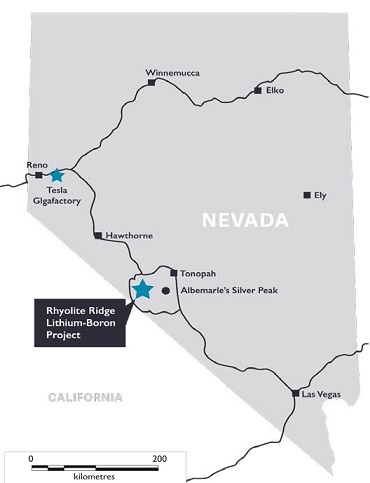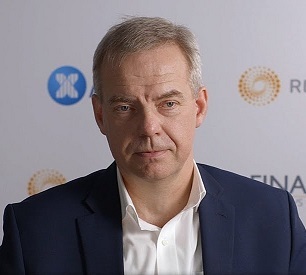One of the recent high-calibre appointments to Global Geoscience’s (ASX: GSC) board, Calaway is not alone in thinking the “exciting lithium-boron growth” opportunity at Rhyolite Ridge in Nevada could be one of the best undeveloped projects (of any kind) in the world at the moment.
“No other projects in North America have the potential to be large, low-cost producers of both lithium and boron on the scale of Rhyolite Ridge,” he says.
Callaway was joined on the GSC board by former Rio Tinto Energy and Minerals CEO, Alan Davies, and ex-Shell Oil president, John Hofmeister, as the corporate minnow ‘remodelled’ internally in preparation for the major external changes to come.
GSC CEO Bernard Rowe says Davies, who headed America’s only domestic boric acid supplier, is certainly someone who recognises the strategic value of the boron and lithium at Rhyolite Ridge and sees the emerging project as a structurally low-cost producer of both commodities.
“In our view, American customers would welcome an alternative domestic cost-competitive boric acid supplier,” Rowe says.
"The US is the second largest market for boric acid so Rhyolite Ridge’s production is likely to be absorbed domestically with a minimal impact on price."
GSC’s 100%-owned Rhyolite Ridge project, 25km west of Albermarle’s Silver Peak lithium mine and 340km from the Tesla Gigafactory near Reno, is also close to California ports for low-cost export of both lithium and boric acid to Asia.

Adding to Davies’ market insight, Calaway and Hofmeister bring to GSC their considerable energy sector experience. Rowe says both see the role Rhyolite Ridge can play in the “global transformation of the transportation and energy sectors – without doubt the most significant changes in the past century”.
With a circa-212% rise in its share price in the past 12 months, GSC’s market value may be just starting to reflect the potential earning power of its unique new project. Its US$192 million market cap is certainly only scratching the surface of what’s been outlined to date in the ground at Rhyolite Ridge.
GSC’s board decided the company could afford to bypass the standard preliminary economic assessment (PEA) stage and move straight into pre-feasibility study work, such were the compelling numbers around a proposed start-up operation producing lithium carbonate and boric acid from the outcropping South Basin deposit at Rhyolite Ridge.
Assuming a processing rate of 2Mtpa of ore, the project would generate revenue of about US$240Mpa split equally between lithium carbonate (US$8,000/t conservative long-term pricing) and boric acid ($800/t). On the preliminary operating cost estimates in GSC’s current investor presentation, operating margins of 100% would be achievable with Rhyolite Ridge producing lithium carbonate and boric acid at roughly half the long-term prices being used.
Rowe says Rhyolite Ridge will be “structurally low cost” due to open pit mining from the surface and the envisaged low-cost acid-leach processing of the project’s unique searlesite-hosted boron and lithium.
“The targeted cost of producing lithium puts Rhyolite Ridge in the middle of the lithium cost curve … before you take into account the profits from the boric acid,” he says.
“Demand for both products is increasing strongly for a range of end uses, driven by new technology and the world focusing on using energy more efficiently.
“We’re seeing strong demand for both products in North America and Asia where there is limited supply.”
The South Basin’s resource of 65Mt of 1% Li2CO3 and 9.1% H3BO3 in the higher grade upper zone has thick zones of relatively soft material that can be mined at a low strip ratio. Rowe says the large outcropping initial resource is also going to underpin GSC’s scaleable production approach.
Recently completed drilling to infill and extend the upper zone is likely to soon provide a substantial increase in the high-grade portion of the resource.
Rowe says the main resource is open in three directions, and large parts of the North and South basins remain untested.
“The [total project] resource is likely to grow substantially with further drilling,” he says.

On the broader value picture, Rowe says GSC’s current market capitalisation imputes a value for Rhyolite Ridge’s initial resource (containing 3.4Mt of lithium carbonate) of only about A$75/t (US$60/t) in the ground – “significantly less if you include the boron”.
“We compare very favourably to our peers,” he says.
“Our closest peer is the Jadar lithium-boron deposit owned by Rio, so difficult to compare market value with that deposit. But Rhyolite Ridge compares very well on fundamentals with Jadar and with other sedimentary lithium deposits as they don't have boron and require more expensive processing.
“The deposit and processing, and proximity to existing infrastructure in Nevada, give us a number of advantages, from the much lower capital intensity than the brine lithium producers, and much lower operating costs compared to spodumene lithium producers due to mining and processing soft ore mined at a very low strip ratio, to the co-product revenue streams.
“Compared with other [sedimentary] lithium projects, Rhyolite Ridge has shown that its low-clay ore and metallurgy will enable us to achieve excellent recoveries without the need to roast, with low acid consumption levels.”
GSC is completing mining optimisation and engineering studies that are feeding into the PFS due to be wrapped up in early 2018.
Rowe says current phase-two metallurgical work due to be completed next month aims to refine and improve the existing planned acid-leach process and also test alternatives that might further lower capex and opex.
“At the end of the current program we will have a full process flowsheet that will feed into the PFS,” he says.
“Our mining consultants RPM are currently undertaking a pit limit optimisation analysis which will determine the preferred approach to pit development.
“The information generated will feed directly into the detailed mining study once the resource upgrade is completed. The study will allow the preparation of a conceptual site layout.
“Environmental work is focussing on establishing baseline studies including climatology and hydrology.”
Rowe says formal environmental permitting will start next year after Rhyolite Ridge’s PFS-level site plan is finalised.
“The PFS is expected to demonstrate the robust economics of Rhyolite Ridge and place it firmly in the low-cost category of global lithium producers,” he says.
“The company will move quickly into DFS and mine permitting will be well underway and a decision to mine will be visible on the horizon.”
Global Geoscience – at a glance
HEAD OFFICE: Suite 203, 161 Walker Street North Sydney NSW 2060 Telephone: +61 (2) 9922-5800 Email: explore@globalgeo.com.au Web: www.globalgeo.com.au DIRECTORS: James Calaway, Bernard Rowe, Alan Davies, Patrick Elliott, John Hofmeister QUOTED SHARES ON ISSUE: 1,139m MARKET CAP (at September 6, 2017): A$227.86 million MAJOR SHAREHOLDERS: HSBC (8.22%), MYCATMAX (7.42%), Holdrey (5.1%), White Swan Nominees (5%)
|


























